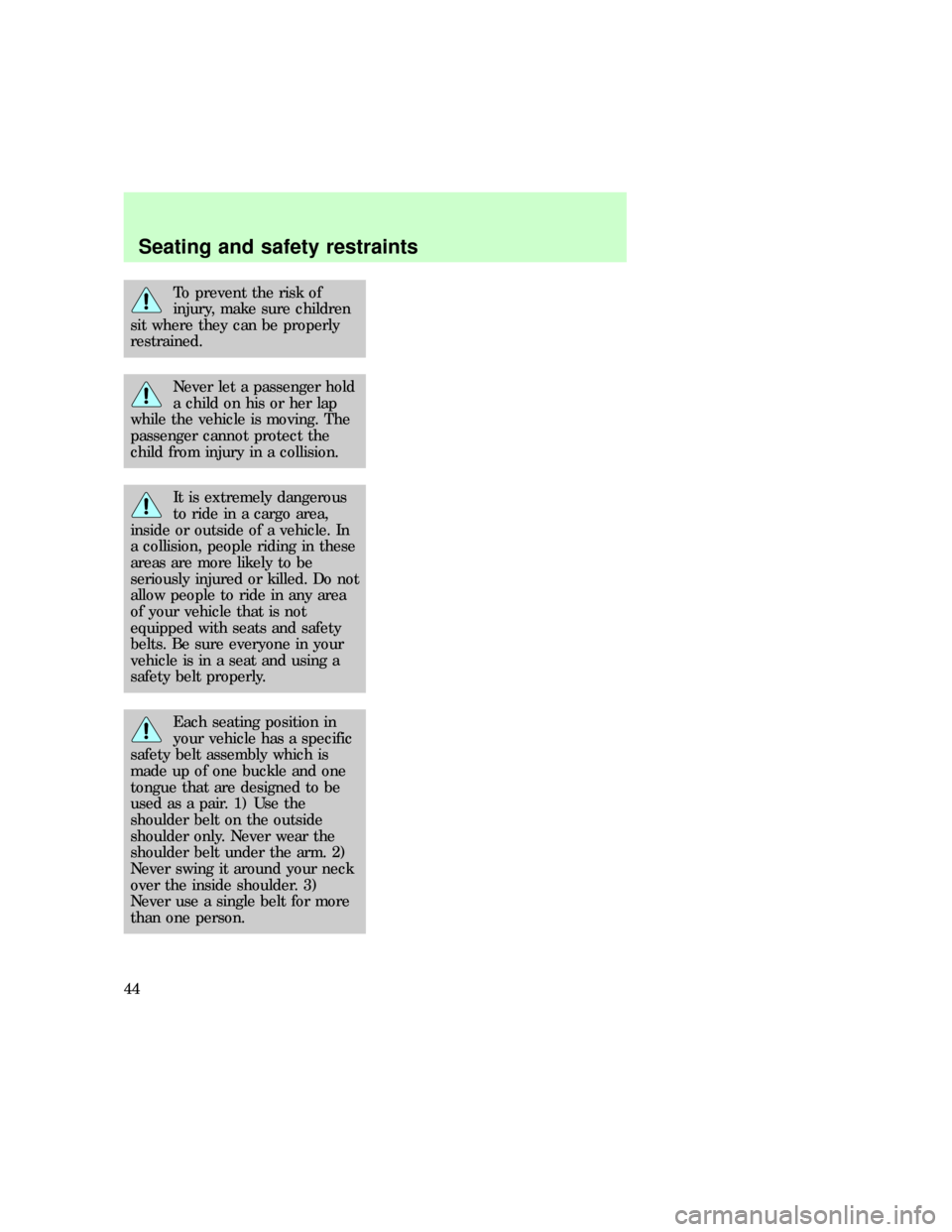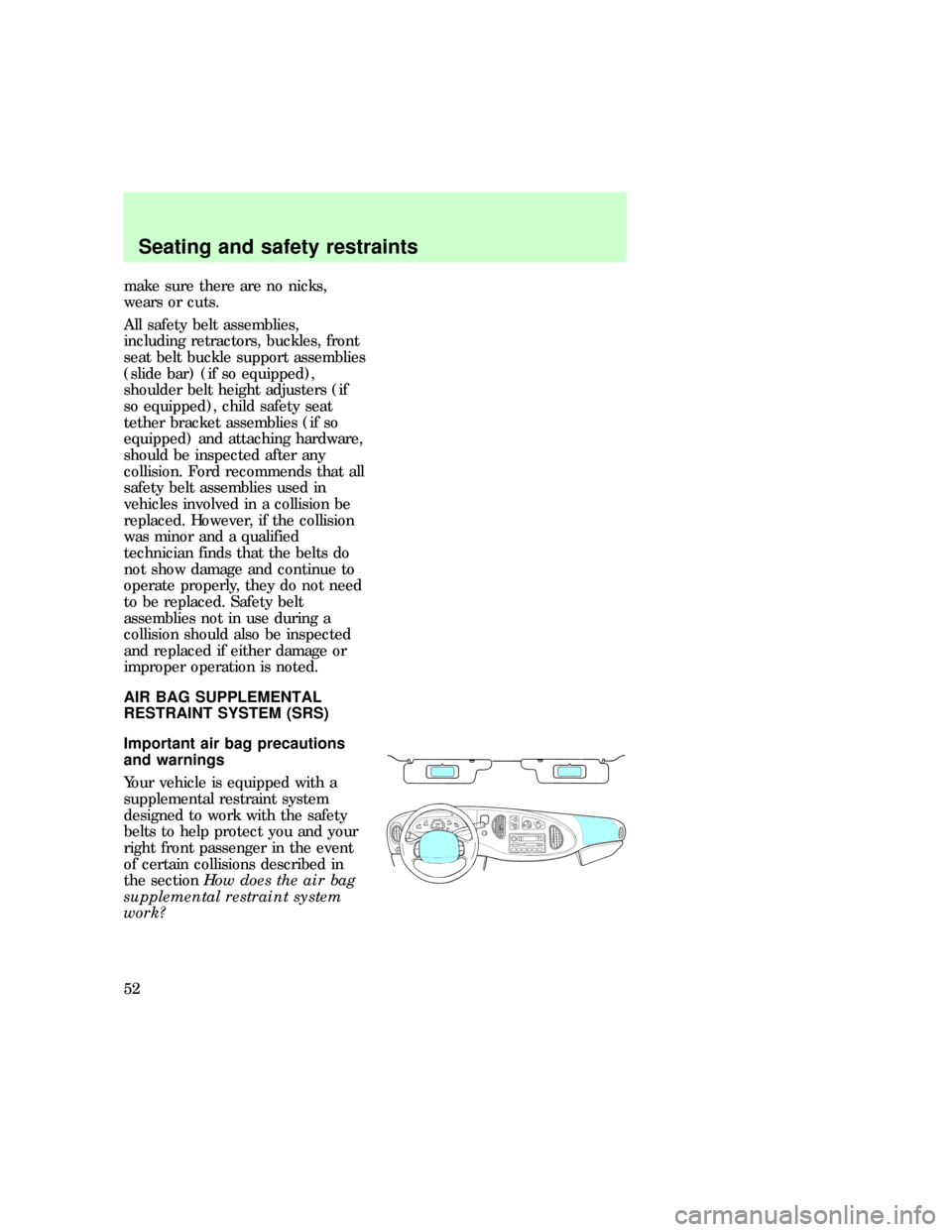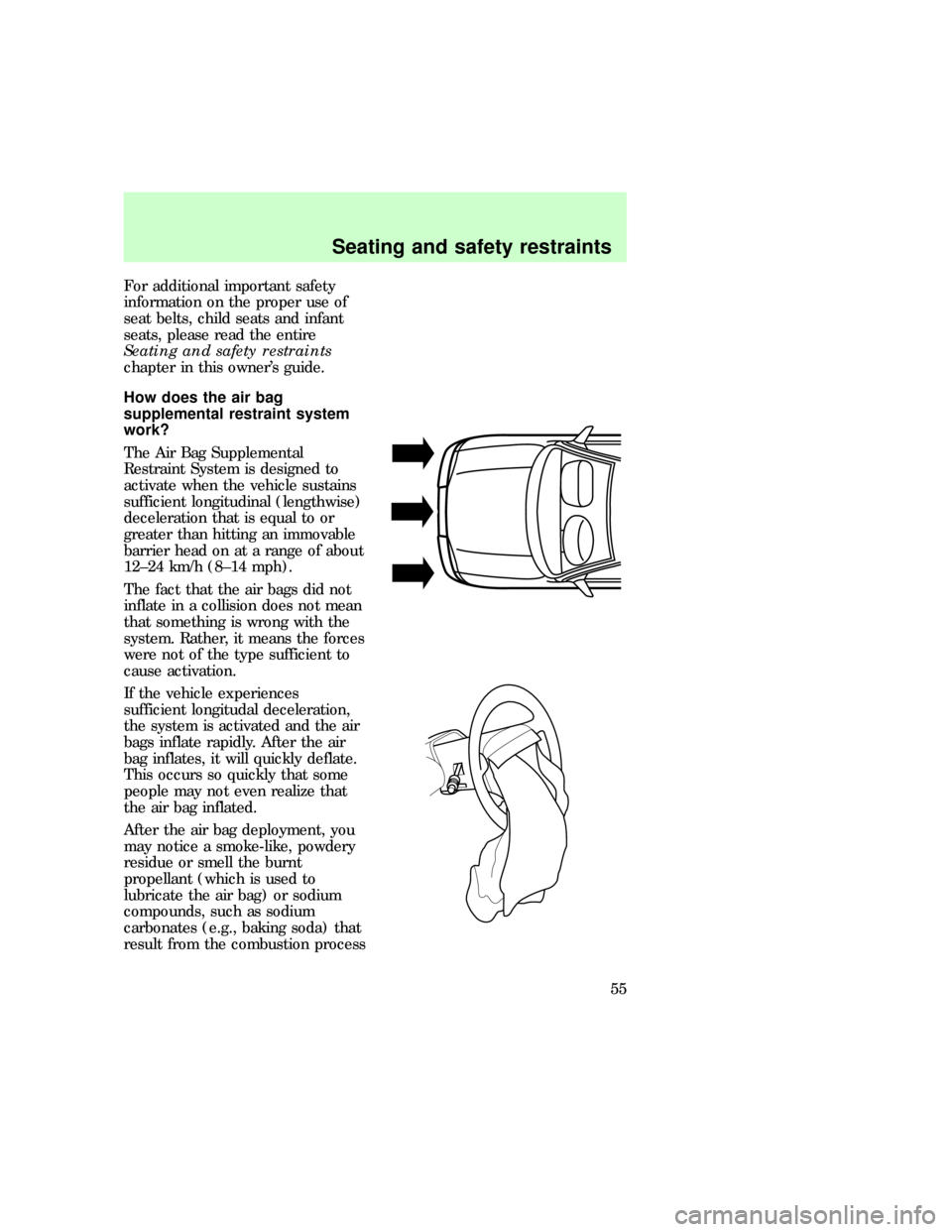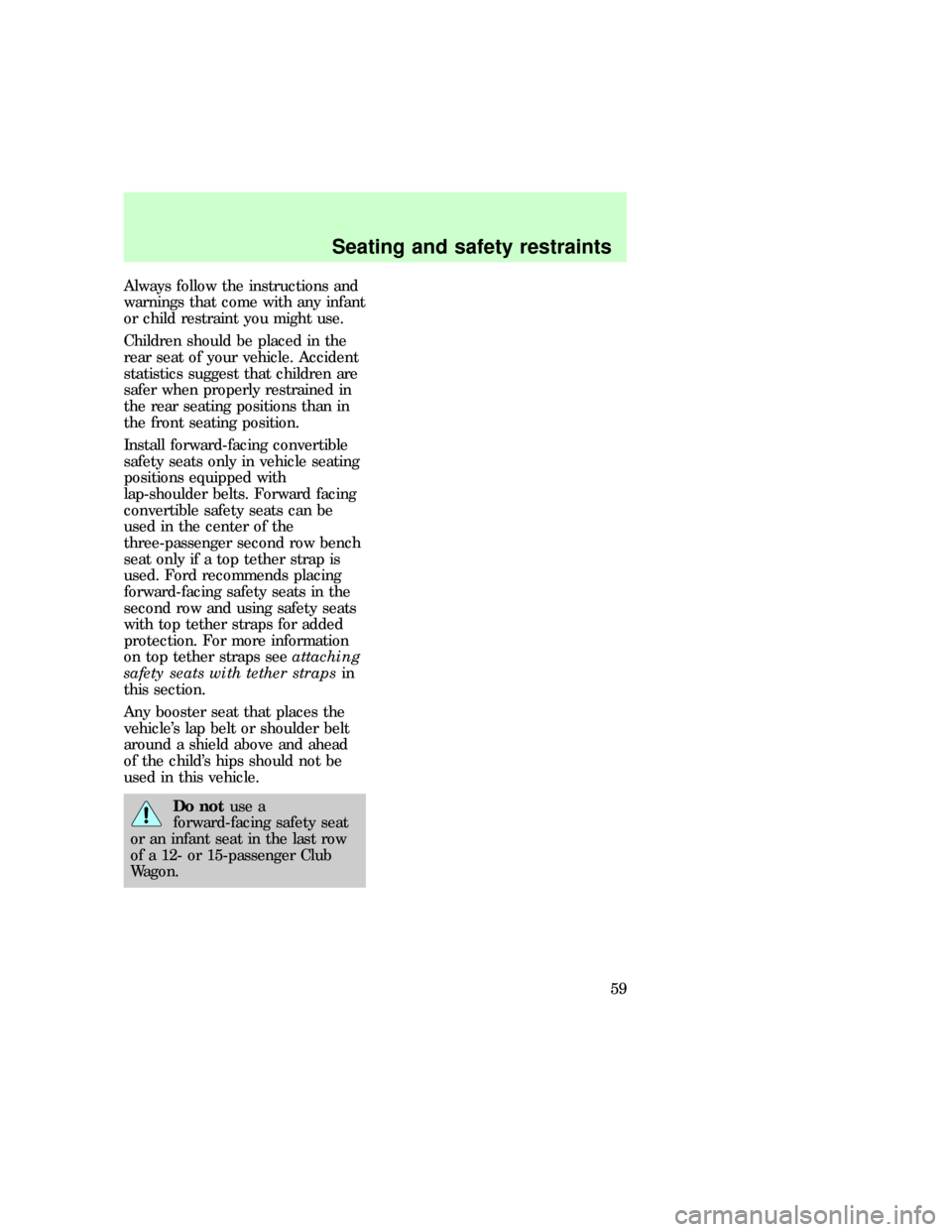Page 44 of 192

To prevent the risk of
injury, make sure children
sit where they can be properly
restrained.
Never let a passenger hold
a child on his or her lap
while the vehicle is moving. The
passenger cannot protect the
child from injury in a collision.
It is extremely dangerous
to ride in a cargo area,
inside or outside of a vehicle. In
a collision, people riding in these
areas are more likely to be
seriously injured or killed. Do not
allow people to ride in any area
of your vehicle that is not
equipped with seats and safety
belts. Be sure everyone in your
vehicle is in a seat and using a
safety belt properly.
Each seating position in
your vehicle has a specific
safety belt assembly which is
made up of one buckle and one
tongue that are designed to be
used as a pair. 1) Use the
shoulder belt on the outside
shoulder only. Never wear the
shoulder belt under the arm. 2)
Never swing it around your neck
over the inside shoulder. 3)
Never use a single belt for more
than one person.
eco_seat-belt_pretensioners
Seating and safety restraints
44
Page 47 of 192
Vehicle sensitive (emergency)
locking mode
In this mode, the shoulder belt will
allow freedom of movement,
locking tight only on hard braking,
hard cornering or impacts of
approximately 8 km/h (5 mph) or
more. The front seat belts can also
be made to lock by jerking on the
belt.
Automatic locking mode
In this mode, the safety belt is
locked in a certain position by the
occupant and remains locked until
the webbing is fully retracted.
The automatic locking mode is not
available on the driver belt.
When to use the automatic
locking mode
²When a tight lap/shoulder fit is
desired.
²Any timea child safety seat is
installed in the vehicle. Refer to
Children and infant or Child
safety seatslater in this section.
eco_locking-mode_use
eco_how-to-use_locking-mode
Seating and safety restraints
47
Page 52 of 192

make sure there are no nicks,
wears or cuts.
All safety belt assemblies,
including retractors, buckles, front
seat belt buckle support assemblies
(slide bar) (if so equipped),
shoulder belt height adjusters (if
so equipped), child safety seat
tether bracket assemblies (if so
equipped) and attaching hardware,
should be inspected after any
collision. Ford recommends that all
safety belt assemblies used in
vehicles involved in a collision be
replaced. However, if the collision
was minor and a qualified
technician finds that the belts do
not show damage and continue to
operate properly, they do not need
to be replaced. Safety belt
assemblies not in use during a
collision should also be inspected
and replaced if either damage or
improper operation is noted.
AIR BAG SUPPLEMENTAL
RESTRAINT SYSTEM (SRS)
Important air bag precautions
and warnings
Your vehicle is equipped with a
supplemental restraint system
designed to work with the safety
belts to help protect you and your
right front passenger in the event
of certain collisions described in
the sectionHow does the air bag
supplemental restraint system
work?
eco_air-bags
eco_important_precautions
Seating and safety restraints
52
Page 53 of 192
All occupants of the
vehicle, including the
driver, should always wear their
safety belts, failure to do so may
increase the risk of personal
injury in the event of a collision.
The right front passenger
air bag is not designed to
restrain occupants in the center
front seating position.
Do not place objects or
mount equipment on or
near the dashboard area,
steering wheel or in front of the
passenger that may come in
contact with a deploying air bag.
Failure to follow this instruction
may increase the risk of personal
injury in the event of a collision.
Do not attempt to service,
repair, or modify the Air
Bag Supplemental Restraint
System or its fuses. See your
Ford or Lincoln-Mercury dealer.
If you are close to an
inflating air bag, it could
seriously injure you. Sit against
the seatback and position your
seat such that it is as far back
from the steering wheel as
possible but still allows you to
properly control the vehicle.
eco_children
Seating and safety restraints
53
Page 54 of 192
Children and air bags
Children should be placed
in the rear in an
appropriate child safety seat that
is properly secured to the
vehicle.
Children should always
wear their safety belts.
Failure to follow this instruction
may increase the risk of personal
injury in the event of a collision.
Rear-facing infant seats
MUST always be secured
in the rear seat. In vehicles
without a rear seat, a rear-facing
infant seat should be secured in
the front seat ONLY if your
vehicle does not have a
passenger side air bag or your
vehicle is equipped with a
passenger air bag deactivate
switch and the switch is turned
to ªOFF.º
When using forward-facing
child safety seats in
vehicles with only two seating
positions so the forward-facing
child safety seat cannot be
placed in the rear of the vehicle,
move the passenger seat as far
back from the instrument panel
as possible. Never secure
rear-facing infant seats in the
front seat.
Seating and safety restraints
54
Page 55 of 192

For additional important safety
information on the proper use of
seat belts, child seats and infant
seats, please read the entire
Seating and safety restraints
chapter in this owner's guide.
How does the air bag
supplemental restraint system
work?
The Air Bag Supplemental
Restraint System is designed to
activate when the vehicle sustains
sufficient longitudinal (lengthwise)
deceleration that is equal to or
greater than hitting an immovable
barrier head on at a range of about
12±24 km/h (8±14 mph).
The fact that the air bags did not
inflate in a collision does not mean
that something is wrong with the
system. Rather, it means the forces
were not of the type sufficient to
cause activation.
If the vehicle experiences
sufficient longitudal deceleration,
the system is activated and the air
bags inflate rapidly. After the air
bag inflates, it will quickly deflate.
This occurs so quickly that some
people may not even realize that
the air bag inflated.
After the air bag deployment, you
may notice a smoke-like, powdery
residue or smell the burnt
propellant (which is used to
lubricate the air bag) or sodium
compounds, such as sodium
carbonates (e.g., baking soda) that
result from the combustion process
eco_how_work
Seating and safety restraints
55
Page 58 of 192

If any of these things happen, even
intermittently, have the SRS
serviced at your dealership or by a
qualified technician immediately.
Unless serviced, the system may
not function properly in the event
of a collision.
Disposal of air bags and air bag
equipped vehicles
For disposal of air bags or air bag
equipped vehicles, see your local
dealership or qualified technician.
Air bags MUST BE disposed of by
qualified personnel.
SAFETY RESTRAINTS FOR
CHILDREN
Important child restraint
precautions
You are required by law to use
safety restraints for children in the
U.S. and Canada. If small children
ride in your vehicle (generally
children who are four years old or
younger and who weigh 18 kg [40
lbs] or less), you must put them in
safety seats made especially for
children. Check your local and
state laws for specific
requirements regarding the safety
of children in your vehicle.
Never let a passenger hold
a child on his or her lap
while the vehicle is moving. The
passenger cannot protect the
child from injury in a collision.
com_disposal.01
eco_child_restraints
eco_important_precautions
Seating and safety restraints
58
Page 59 of 192

Always follow the instructions and
warnings that come with any infant
or child restraint you might use.
Children should be placed in the
rear seat of your vehicle. Accident
statistics suggest that children are
safer when properly restrained in
the rear seating positions than in
the front seating position.
Install forward-facing convertible
safety seats only in vehicle seating
positions equipped with
lap-shoulder belts. Forward facing
convertible safety seats can be
used in the center of the
three-passenger second row bench
seat only if a top tether strap is
used. Ford recommends placing
forward-facing safety seats in the
second row and using safety seats
with top tether straps for added
protection. For more information
on top tether straps seeattaching
safety seats with tether strapsin
this section.
Any booster seat that places the
vehicle's lap belt or shoulder belt
around a shield above and ahead
of the child's hips should not be
used in this vehicle.
Do notuse a
forward-facing safety seat
or an infant seat in the last row
of a 12- or 15-passenger Club
Wagon.
eco_safety_belts
Seating and safety restraints
59